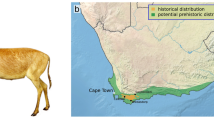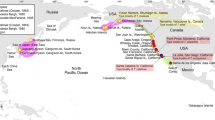Abstract
The giant sable antelope (Hippotragus niger variani), unique to Angola, was feared extinct after almost three decades of civil war. Comparisons of mitochondrial DNA sequences derived from dung samples recently collected in the field and from old museum specimens of certain provenance provide the first documented evidence to date that this enigmatic antelope has survived. Its DNA-led rediscovery in the former combat zone was subsequently confirmed by photographic evidence. The Angolan isolate constitutes a distinct monophyletic group that shows a dramatic population decline from historic levels. It represents a diagnosable conservation unit which is characterised by unique cranial morphological features (Blaine 1922 1922:317–339), a highly restricted range, and the presence of fixed genetic differences in all of its common relatives.



Similar content being viewed by others
References
Aasen E, Medrano JF (1990) Amplification of the ZFY and ZFX genes for sex identification in humans, cattle, sheep and goats. Biotechnology 8:1279–1281
Alpers DL, VanVuuren BJ, Arctander P, Robinson TJ (2004) Population genetics of the roan antelope (Hippotragus equinus) with suggestions for conservation. Mol Ecol 13:1771–1784
Ansell WFH (1971) Order Artiodactyla. In: Meester J, Setzer HW (eds), The mammals of Africa: an identification manual, part 15. Smithsonian Institution, Washington, District of Columbia, p 184
Avise JC (2004) Molecular markers, natural history, and evolution. 2nd ed., Sinauer Associates, Sunderland (Massachusetts)
Blaine G (1922) Notes on the zebras and some antelopes of Angola. Proc Zool Soc Lond 1922:317–339
Burger J, Pfeiffer I, Hummel S, Fuchs R, Brenig B, Herrmann B (2001) Mitochondrial and nuclear DNA from (pre)historic hide-derived material. Anc Biomol 3:227–238
Cabral JC (1970) Alguns Aspectos da Ecologia da Palanca Real (Hippotragus niger variani Thomas). Bull Instituto de Investigação Científica de Angola 7:5–38
Creel S, Spong G, Sands JL, Rotella J, Zeigle J, Joe L, Murphy KM, Smith D (2003) Population size estimation in Yellowstone wolves with error-prone noninvasive microsatellite genotypes. Mol Ecol 12:2003–2009
Davis JI, Nixon KC (1992) Populations, genetic variation, and the delimitation of phylogenetic species. Syst Biol 41:421–435
DeSalle R, Amato G (2004) The expansion of conservation genetics. Nat Rev Genet 5:702–712
Estes RD (1983) Sable by moonlight. Anim Kingd 86:10–16
Estes RD, Estes RK (1974) The biology and conservation of the giant sable antelope Hippotragus niger variani Thomas, 1916. Proc Acad Nat Sci Philadelphia 126:73–104
Frade F, Sieiro D (1960) Palanca preta gigante de Angola. Junta de Investigações do Ultramar, Lisboa, Garcia de Orta 8:21–38
Groves CP (1983) A new subspecies of sable antelope, Hippotragus niger (Harris 1938). Rev Zool Afr 97:821–828
Herbert PDN, Cywinska A, Ball SL, deWaard JR (2003) Biological identifications through DNA barcodes. Proc R Soc Lond B Biol Sci 270:313–321
Hoelzel AR, Hancock JM, Dover GA (1991) Evolution of the cetacean mitochondrial d-loop region. Mol Biol Evol 8:475–493
Hofreiter M, Serre D, Poinar HN, Kuch M, Paabo S (2001) Ancient DNA. Nat Rev Genet 2:353–359
Irwin DM, Kocher TD, Wilson AC (1991) Evolution of cytochrome b gene of mammals. J Mol Evol 32:128–144
Kocher TD, Thomas WK, Meyer A, Edwards SV, Paabo S, Villablanca FX, Wilson AC (1989) Dynamics of mitochondrial DNA evolution in animals: amplification and sequencing with conserved primers. Proc Natl Acad Sci U S A 86:6196–6200
Kohn MH, Wayne RK (1997) Facts from feces revisited. TREE 12:223–227
Kumar S, Tamura K, Nei M (1993) MEGA: molecular evolutionary genetics analysis, version 1.02. Pennsylvania State University, University Park
Mannen H, Tsuji S, Loftus RT, Bradley DG (1998) Mitochondrial DNA variation and evolution of Japanese black cattle (Bos taurus). Genetics 150:1169–1175
Matthee CA, Robinson TJ (1999) Mitochondrial DNA population structure of roan and sable antelope: implications for the translocation and conservation of the species. Mol Ecol 8:227–238
Mochi U, Carter TD (1971) Hoofed mammals of the world. Charles Scribner’s Sons
Paabo S, Wilson AC (1988) Polymerase chain reaction reveals cloning artefacts. Nature 334:387–838
Palomares F, Godoy JA, Piriz A, O'Brien SJ, Johnson WE (2002) Faecal genetic analysis to determine the presence and distribution of elusive carnivores: design and feasibility for the Iberian lynx. Mol Ecol 11:2171–2182
Palumbi SR, Martin A, Romano S, McMillan WO, Stice L (1991) The simple fool’s guide to PCR. Department of Zoology and Kewalo Marine Laboratory, University of Hawaii, Honolulu
Pitra C, Hansen AJ, Lieckfeldt D, Arctander P (2002) An exceptional case of historical outbreeding in African sable antelope populations. Mol Ecol 11:1197–1208
Posada D, Crandall KA (1998) Modeltest: testing the model of DNA substitution. Bioinformatics 14:817–818
Shields GF, Kocher TD (1991) Phylogenetic relationships of North American ursids based on analysis of mitochondrial DNA. Evolution 45:218–221
Sites JW, Marshall JC (2003) Delimiting species: a Renaissance issue in systematic biology. TREE 18:462–470
Swofford DL (2001) PAUP*: phylogenetic analysis using parsimony (*and Other Methods) Sinauer Associates, Sunderland, Massachusetts
Thomas O (1916) A new sable antelope from Angola. Proc Zool Soc Lond 1916:298–301
Vogler AP, DeSalle R (1994) Diagnosing units of conservation management. Conserv Biol 8:354–363
Walker JF (2002) A certain curve of horn: the hundred-year quest for the giant sable antelope of Angola. Atlantic Monthly
Walther FR (1990) Roan and Sable Antelopes. In: Parker SP (ed) Grzimek’s Encyclopedia of mammals, vol. 5. McGraw-Hill, New York, pp 437–447
Wilson DE, Reeder DM (1993) Mammal species of the world (2nd edn). Smithsonian Institution, Washington
Acknowledgements
We wish to thank the Angolan Authorities for their support in conducting this research. We thank Mr. Cristóvão da Cunha, the Governor of Malange, and General Hanga of Angolan Air Force, Messrs. Werner and Wolfram Brock, Dr. Miguel Morais, Mr. Abias Huongo and all the local assistants (giant sable “shepherds”). Anke Schmidt and Dr. Joerns Fickel of the Institute for Zoo and Wildlife Research Berlin, Dr. Jeremy Anderson of the IUCN Antelope Specialist Group, Michael Eustace of African Parks, Pierre van Heerden of Oracle Television, Dr Rolf Baldus of the GTZ-Tanzania Wildlife programme, Benson Kibonde, Joe Holmes, Peter Vosloo, Frits Eloff and Mr Bebecca provided assistance. The Powell-Cotton Museum (Malcolm Harman) and the Field Museum of Natural History, Chicago (Dr. Bill Stanley) kindly provided access to giant sable specimens housed in their collections. This research was funded in part by UNDP and PAPS, African chapter of SCI, the Dallas Safari Club, and the South African National Research Foundation (GUN 2053617). The Angolan Air Force provided logistic support.
Author information
Authors and Affiliations
Corresponding author
Rights and permissions
About this article
Cite this article
Pitra, C., VazPinto, P., O’Keeffe, B.W.J. et al. DNA-led rediscovery of the giant sable antelope in Angola. Eur J Wildl Res 52, 145–152 (2006). https://doi.org/10.1007/s10344-005-0026-y
Received:
Accepted:
Published:
Issue Date:
DOI: https://doi.org/10.1007/s10344-005-0026-y




